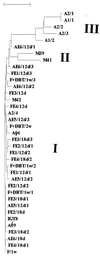Analysis of bacterial community structure in sulfurous-oil-containing soils and detection of species carrying dibenzothiophene desulfurization (dsz) genes
- PMID: 11229891
- PMCID: PMC92694
- DOI: 10.1128/AEM.67.3.1052-1062.2001
Analysis of bacterial community structure in sulfurous-oil-containing soils and detection of species carrying dibenzothiophene desulfurization (dsz) genes
Abstract
The selective effects of sulfur-containing hydrocarbons, with respect to changes in bacterial community structure and selection of desulfurizing organisms and genes, were studied in soil. Samples taken from a polluted field soil (A) along a concentration gradient of sulfurous oil and from soil microcosms treated with dibenzothiophene (DBT)-containing petroleum (FSL soil) were analyzed. Analyses included plate counts of total bacteria and of DBT utilizers, molecular community profiling via soil DNA-based PCR-denaturing gradient gel electrophoresis (PCR-DGGE), and detection of genes that encode enzymes involved in the desulfurization of hydrocarbons, i.e., dszA, dszB, and dszC. Data obtained from the A soil showed no discriminating effects of oil levels on the culturable bacterial numbers on either medium used. Generally, counts of DBT degraders were 10- to 100-fold lower than the total culturable counts. However, PCR-DGGE showed that the numbers of bands detected in the molecular community profiles decreased with increasing oil content of the soil. Analysis of the sequences of three prominent bands of the profiles generated with the highly polluted soil samples suggested that the underlying organisms were related to Actinomyces sp., Arthrobacter sp., and a bacterium of uncertain affiliation. dszA, dszB, and dszC genes were present in all A soil samples, whereas a range of unpolluted soils gave negative results in this analysis. Results from the study of FSL soil revealed minor effects of the petroleum-DBT treatment on culturable bacterial numbers and clear effects on the DBT-utilizing communities. The molecular community profiles were largely stable over time in the untreated soil, whereas they showed a progressive change over time following treatment with DBT-containing petroleum. Direct PCR assessment revealed the presence of dszB-related signals in the untreated FSL soil and the apparent selection of dszA- and dszC-related sequences by the petroleum-DBT treatment. PCR-DGGE applied to sequential enrichment cultures in DBT-containing sulfur-free basal salts medium prepared from the A and treated FSL soils revealed the selection of up to 10 distinct bands. Sequencing a subset of these bands provided evidence for the presence of organisms related to Pseudomonas putida, a Pseudomonas sp., Stenotrophomonas maltophilia, and Rhodococcus erythropolis. Several of 52 colonies obtained from the A and FSL soils on agar plates with DBT as the sole sulfur source produced bands that matched the migration of bands selected in the enrichment cultures. Evidence for the presence of dszB in 12 strains was obtained, whereas dszA and dszC genes were found in only 7 and 6 strains, respectively. Most of the strains carrying dszA or dszC were classified as R. erythropolis related, and all revealed the capacity to desulfurize DBT. A comparison of 37 dszA sequences, obtained via PCR from the A and FSL soils, from enrichments of these soils, and from isolates, revealed the great similarity of all sequences to the canonical (R. erythropolis strain IGTS8) dszA sequence and a large degree of internal conservation. The 37 sequences recovered were grouped in three clusters. One group, consisting of 30 sequences, was minimally 98% related to the IGTS8 sequence, a second group of 2 sequences was slightly different, and a third group of 5 sequences was 95% similar. The first two groups contained sequences obtained from both soil types and enrichment cultures (including isolates), but the last consisted of sequences obtained directly from the polluted A soil.
Figures





References
-
- Angert E R, Northup D E, Reysenbach A-L, Peek A S, Goebel B M, Pace N R. Molecular phylogenetic analysis of a sulfide-based microbial community in Sulphur River, Parker Cave, Kentucky. Am Mineral. 1998;83:1583–1592.
-
- Brosius J, Dull T J, Sleeter D D, Noller H F. Gene organization and primary structure of a ribosomal RNA operon from Escherichia coli. J Mol Biol. 1981;148:107–127. - PubMed
Publication types
MeSH terms
Substances
Associated data
- Actions
- Actions
- Actions
- Actions
- Actions
- Actions
- Actions
- Actions
- Actions
- Actions
- Actions
- Actions
- Actions
- Actions
- Actions
- Actions
- Actions
- Actions
- Actions
LinkOut - more resources
Full Text Sources
Molecular Biology Databases

